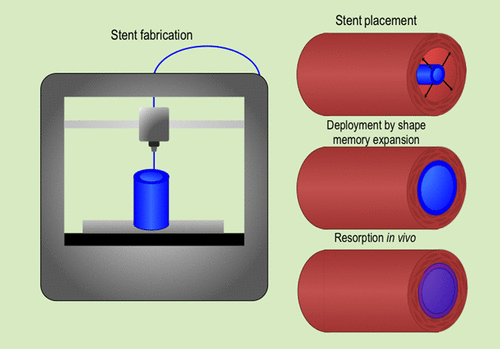当前位置:
X-MOL 学术
›
Biomacromolecules
›
论文详情
Our official English website, www.x-mol.net, welcomes your
feedback! (Note: you will need to create a separate account there.)
Advancing Towards 3D Printing of Bioresorbable Shape Memory Polymer Stents.
Biomacromolecules ( IF 5.5 ) Pub Date : 2020-09-14 , DOI: 10.1021/acs.biomac.0c01082 Taylor R Yeazel 1 , Matthew L Becker 1, 2
Biomacromolecules ( IF 5.5 ) Pub Date : 2020-09-14 , DOI: 10.1021/acs.biomac.0c01082 Taylor R Yeazel 1 , Matthew L Becker 1, 2
Affiliation

|
Stents have evolved significantly since their introduction to the medical field in the early 1980s, becoming widely used in percutaneous coronary interventions and following nephrological procedures. However, the current commercially available stents do not degrade and remain in the body forever, leading to problems like restenosis in cardiovascular applications or requiring removal procedures in ureteral applications. Efforts to replace metal with resorbable materials have largely been halted after the commercial failure of and safety concerns elicited by Abbott’s Absorb stent in 2017. Industry continues to use common polymers such as poly(l-lactide) (PLLA) and polycaprolactone (PCL) for biomedical products, but due to the weak mechanical properties of these bioresorbable materials in comparison to metals, these devices have struggled to accomplish the goals set, increasing risk of thrombosis. 3D printing stents using bioresorbable and shape memory materials could provide a method of patient-personalized production, remove the need for balloon expansion, and limit stent migration, thus bringing a new age of stent technology. The investigation of a range of 3D-printable and bioresorbable shape-memory polymers can provide solutions to the shortcomings of previously explored bioresorbable stents and revitalize the medical device industry efforts into advancing stent technology.
中文翻译:

朝着生物可吸收形状记忆聚合物支架的3D打印迈进。
自从1980年代初期将其引入医学领域以来,支架已经有了长足的发展,已广泛用于经皮冠状动脉介入治疗和遵循肾脏病学程序。然而,当前市售的支架不会永久降解并保留在体内,从而导致诸如心血管应用中的再狭窄或输尿管应用中需要移除程序的问题。在2017年雅培的Absorb支架因商业原因失败并引发安全隐患后,用可吸收材料替代金属的努力已基本停止。工业界继续使用诸如聚(l-丙交酯(PLLA)和聚己内酯(PCL)用于生物医学产品,但是由于这些可生物吸收的材料与金属相比机械性能较弱,因此这些设备难以实现既定目标,从而增加了血栓形成的风险。使用生物可吸收材料和形状记忆材料的3D打印支架可以提供一种个性化患者生产的方法,消除气球膨胀的需要,并限制支架的移动,从而带来了支架技术的新时代。对一系列可3D打印和可生物吸收的形状记忆聚合物的研究可为以前探索的可生物吸收支架的缺点提供解决方案,并振兴医疗器械行业努力发展支架技术。
更新日期:2020-10-12
中文翻译:

朝着生物可吸收形状记忆聚合物支架的3D打印迈进。
自从1980年代初期将其引入医学领域以来,支架已经有了长足的发展,已广泛用于经皮冠状动脉介入治疗和遵循肾脏病学程序。然而,当前市售的支架不会永久降解并保留在体内,从而导致诸如心血管应用中的再狭窄或输尿管应用中需要移除程序的问题。在2017年雅培的Absorb支架因商业原因失败并引发安全隐患后,用可吸收材料替代金属的努力已基本停止。工业界继续使用诸如聚(l-丙交酯(PLLA)和聚己内酯(PCL)用于生物医学产品,但是由于这些可生物吸收的材料与金属相比机械性能较弱,因此这些设备难以实现既定目标,从而增加了血栓形成的风险。使用生物可吸收材料和形状记忆材料的3D打印支架可以提供一种个性化患者生产的方法,消除气球膨胀的需要,并限制支架的移动,从而带来了支架技术的新时代。对一系列可3D打印和可生物吸收的形状记忆聚合物的研究可为以前探索的可生物吸收支架的缺点提供解决方案,并振兴医疗器械行业努力发展支架技术。











































 京公网安备 11010802027423号
京公网安备 11010802027423号